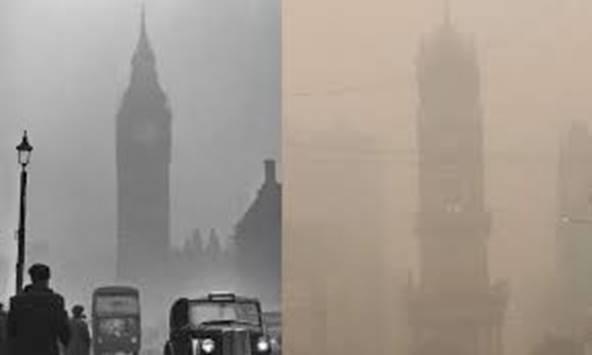
Lahore's deadly air could soon rival London's Great Smog — unless Pakistan follows the hard-earned lessons of the past
Can Lahore Learn from London’s Great Smog of 1952?
By Eric Shahzar
UK
The factories of Manchester and New York were the proud symbols of industrialization, ushering in an era of progress and prosperity in the 18th century. But beneath the chimneys that fueled this golden era lay a darker legacy — they sowed the seeds of the environmental crises we face today.
Rapid industrial growth and carbon emissions have led to climate change, with smog and air pollution among its most glaring reminders of the cost of progress that has come back to haunt us.
The question now looms large: why is Pakistan, a nation contributing less than 1 percent to global carbon emissions, bearing the brunt of this environmental crisis, particularly in Lahore and across Punjab? Smog in this region has become a national security issue, threatening public health and productivity on a massive scale.
But there is hope in the lessons of history — reflecting on how nations like Britain adapted to similar challenges might offer insights for Pakistan.
Death in the air
The smog choking Lahore today is not unprecedented. Let us consider the Great Smog of London in December 1952. That toxic fog, laden with smoke and pollutants, enveloped the city for five days, leading to more than 4,000 deaths. There were even reports of cows choking to death in the fields. It was a harrowing chapter in London’s history, one born from industrial pollution exacerbated by unique weather conditions.
Smog wasn’t new to London. The industrial boom of the 19th and early 20th centuries had long cloaked the city in its murky veil. But nothing prepared Londoners for the scale of 1952’s disaster.
Factories pumping coal smoke into the atmosphere, combined with the widespread burning of coal for heating, created the perfect conditions for disaster. Britain’s experience underscores the fact that unchecked industrial growth carries a heavy cost — and one that Pakistan must urgently address to avoid similar catastrophes.
Smog in London was not just the result of pollution but also specific atmospheric conditions. Under normal circumstances, smoke disperses into the atmosphere. However, in December 1952, an anticyclone created a temperature inversion, trapping smoke and pollutants close to the ground. This deadly mix of industrial emissions and stagnant air culminated in one of the deadliest environmental disasters of the modern age.
Similarly, in Punjab, weather patterns and agricultural practices , such as the burning of crop residue, worsen air quality and trap pollutants near the surface. Without urgent mitigation measures, the region remains vulnerable to an environmental calamity of its own.
The Great Smog of London claimed more than 4,000 lives — a toll so shocking, it jolted an entire nation into action. Now, a different but equally lethal cloud looms over Punjab, where the smog chokes the air and imperils lives. Pakistan stands at the precipice of a disaster of similar magnitude — one it cannot afford to ignore.
Imagine a situation where children gasp for air , schools shut down , and thousands succumb to respiratory illnesses . This is not just an environmental issue; it is a matter of life and death.
Laws without teeth
Following the Great Smog, Britain introduced a series of laws to curb pollution, most notably the Clean Air Acts of 1956 and 1968 . These laws mandated the use of smokeless fuels in urban areas and required factories to transition away from black smoke emissions. Though it took time for the legislation to show results, these steps ultimately made smog a thing of the past in the UK.
Today, Londoners breathe easier, a testament to the power of coordinated, long-term action. One striking example of London’s commitment to clean air policy is its strict requirement that no local planning authority approves the construction of new buildings or residential homes without ensuring adequate green spaces in the area.
In Pakistan, despite progressive legislation such as Article 9A of the Constitution , which enshrines the right to a clean, healthy, and sustainable environment, and initiatives like the National Clean Air Policy (NCAP) , implementation remains severely lacking.
Those with connections and influence can often bypass regulations and expedite land approvals, resulting in unchecked development that paves over green spaces with impunity. Unlike London, which prioritizes the health and well-being of its citizens, Pakistan’s unregulated urban sprawl risks engulfing its cities in concrete and pollution, undermining efforts toward sustainable living.
Tackling smog is not an overnight task — it demands a sustained, long-term commitment. History has shown that nations that confronted pollution decisively succeeded through strategic policies, public cooperation, and technological advancements.
For Pakistan, the stakes couldn’t be higher. Will the country wait until its smog-laden skies become a global cautionary tale? Or will it seize this moment to champion change, reclaiming its air, its green spaces, and its future? The time to act is now — before the smog of Punjab rivals the tragedy of London’s Great Smog of 1952.
(The writer is an academic at Oxford University, UK, and teaches politics, immigration and environmental law)


